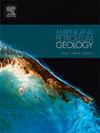杰拉近海(西西里岛南部)潜在二氧化碳封存区的地质特征及重力滑坡的作用
IF 3.7
2区 地球科学
Q1 GEOSCIENCES, MULTIDISCIPLINARY
引用次数: 0
摘要
欧洲政策规定,到 2030 年,二氧化碳排放量要减少 55%,在这种情况下,碳捕集与封存 (CCS) 是实现大幅减排的可行方案。杰拉近海地区的主要特征是杰拉推力系统(GTS)及其相关的杰拉前深(GF),这是一个狭窄(少于 20 千米)、拉长(约 100-120 千米)的剥蚀带,由西西里近海地区较厚的上新世-更新世砂质沉积物组成。该地区被面积达 1500 平方公里的重力滑坡--杰拉滑坡(Gela Slide)所覆盖。该地区的上新世-更新世碎屑岩沉积物在实施碳捕获与储存(CCS)方面的潜力此前尚未得到探索。在这项研究中,我们调查了杰拉近海地区约 840 平方公里的潜在盖岩-储层系统。我们的分析包括从密集的二维地震反射剖面网格中解释关键地层,进行井-地震联系分析,并建立一个精细的速度模型。该潜在储集区由 Sabbie di Irene Fm.的下更新统前深海浊积沙(储层)和 Argo Fm.的中上更新统 pelitic 沉积物(主封层)组成。此外,还对盖拉滑坡的基底剪切层进行了调查,将其作为潜在的次级封存。通过分析其范围、年龄以及与 GTS 之间的相互作用,可以深入了解构造与沉积之间的关系,从而为 CCS 目的确定合适的密封层。这项研究为主要储层和密封层的厚度、深度、岩相和岩石体积提供了新数据,突出了它们在 CCS 应用方面的潜在适用性。本文章由计算机程序翻译,如有差异,请以英文原文为准。
‘’Geological characterization of a potential CO2 storage play in the Gela offshore (southern Sicily) and the role of a gravitational slide’’
In a context where European policies mandating a 55% reduction in CO2 emissions by 2030, Carbon Capture Storage (CCS) presents a viable solution for achieving substantial emissions cuts. Identifying existing and new potential sites for CCS in offshore southern Sicily is crucial to meeting this goal.
The Gela offshore region is predominantly characterized by the Gela Thrust System (GTS) and its associated Gela Foredeep (GF), a narrow (less than 20 km) and elongated (approximately 100–120 km) depozone that comprises the thicker Plio-Pleistocene sandy sediments of the offshore Sicilian sector. This area is covered by the Gela Slide, a 1500 km2 gravitational slide.
The potential of Plio-Pleistocene clastic deposits in this regionfor CCS implementation has not been previously explored. In this study, we investigated a potential caprock-reservoir system covering around 840 km2 in the Gela offshore area. Our analysis involved interpreting key horizons from a dense grid of 2D seismic reflection profiles, conducting well-to-seismic tie analysis and developing a refined velocity model.
The study reveals a promising storage play within the foredeep basin-filling deposits. This potential storage play consists of Lower Pleistocene foredeep turbidite sands of Sabbie di Irene Fm. (reservoir) and of the Middle-Upper Pleistocene pelitic deposits of the Argo Fm. (primary seal). Additionally, the basal shear level of the Gela Slide has been investigated as a potential secondary seal. Analyzing its extent, age, and interaction with the GTS offers valuable insights into the relationships between tectonics and sedimentation, which could lead to the identification of suitable sealing layers for CCS purposes.
This study thus provided new data on the thickness, depth, facies and rock volumes of the main reservoir and seals, highlighting their potential suitability for CCS applications.
求助全文
通过发布文献求助,成功后即可免费获取论文全文。
去求助
来源期刊

Marine and Petroleum Geology
地学-地球科学综合
CiteScore
8.80
自引率
14.30%
发文量
475
审稿时长
63 days
期刊介绍:
Marine and Petroleum Geology is the pre-eminent international forum for the exchange of multidisciplinary concepts, interpretations and techniques for all concerned with marine and petroleum geology in industry, government and academia. Rapid bimonthly publication allows early communications of papers or short communications to the geoscience community.
Marine and Petroleum Geology is essential reading for geologists, geophysicists and explorationists in industry, government and academia working in the following areas: marine geology; basin analysis and evaluation; organic geochemistry; reserve/resource estimation; seismic stratigraphy; thermal models of basic evolution; sedimentary geology; continental margins; geophysical interpretation; structural geology/tectonics; formation evaluation techniques; well logging.
 求助内容:
求助内容: 应助结果提醒方式:
应助结果提醒方式:


